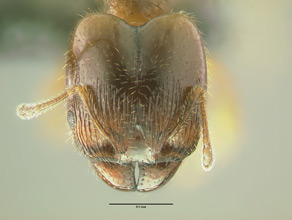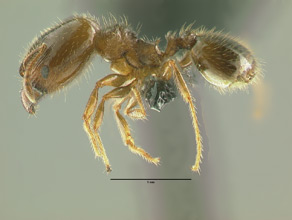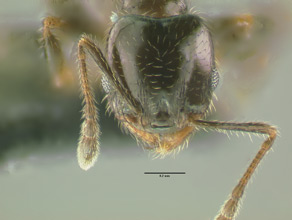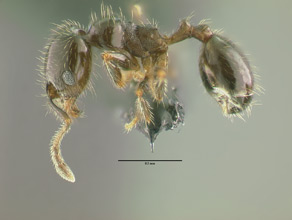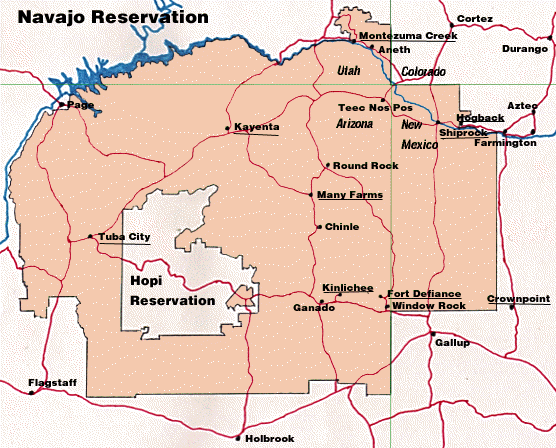- Identification
- The simplest way to distinguish Pheidole from other Navajo ant genera is to find a nest of ants that contains large headed majors and small minors. The 12 segmented antenna of Pheidole bicarinata majors and minors have a 3 segment club and the propodeum is noticeably lower than the promesonotum. Major workers also have two teeth at the margin of their clypeus (bicarinata = two keeled). Both the majors (~2 mm) and minors of this ant are small ants that have a pair of spines on their propodeum.
- Wilson (2003) had this to say about this ant's taxonomy: Pheidole bicarinata is a taxonomically difficult species (or, possibly, complex of closely similar species). It is highly variable, especially geographically, in propodeal and pronotal sculpturing, and in development of the propodeal spine, and in color.
- Biology
- This species appears to have a preference for open sites with sandy soils and habitats that are at the moister end of dry, e.g., grasslands and valley bottoms in arid areas, at least in the west. It also inhabits sites that have some but not all of these characteristics. Gregg (1963) stated Pheidole bicarinata in Colorado was a Sonoran Zone species. In the eastern US (Carter, 1962; Wilson 2003) this ant is common in fields and open grassy locations, including in ruderal sites (sidewalks, lawns, and along the shoulder of roads).
- additional biology notes...
- Distribution
- Range
- United States. from Wilson (2003) - New Jersey to northern Florida and west through Nebraska, Colorado, Texas to Utah and Nevada.
- Navajo Reservation Records
- Samples being processed.
- Additional Notes
- Nests can be found underneath ground-covering objects, within rotten downed wood, and in open ground with a small crater mound revealing the the presence of a subterranean nest. When present soil mounds are typically incomplete, resembling a wedge or crescent. Colonies are small, often just a few hundred workers. Seeds are collected and may be stored in underground nest granaries.
- Etymology
- Morphological. "two keels" The majors have two teeth on their clypeal margin.
Pheidole bicarinata has played a central role in helping us to understand caste determination in ants. Wheeler and Nijhouts' elegant studies used this species to experimentally tease apart how hormones and nutrition may interact to both induce and suppress soldier production. These results were then used to build a model of how larval caste development could be controlled within colonies.
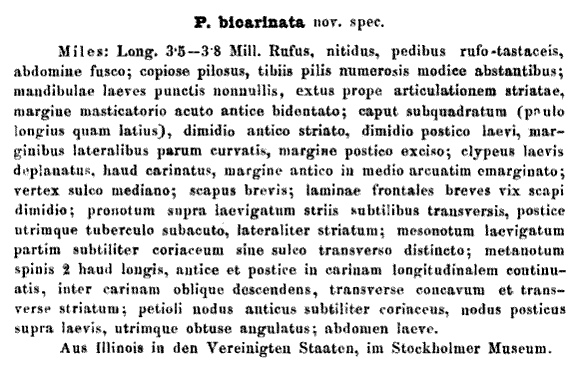


- Literature
- Ballard, J. B. and K. P. Pruess. 1979. Seed selection by an ant Pheidole bicarinata longula Emery (Hymenoptera: Formicidae) in a corn field on 4 different dates during the summer of 1977 in McPherson County, Nebraska. Journal of the Kansas Entomological Society. 52:550-552.
- Beckmann, R. L., Jr and J. M. Stucky. 1981. Extrafloral nectaries and plant guarding in Ipomoea pandurata (L.) G.F.W. Mey. (Convolvulaceae). American Journal of Botany. 68:72-79.
- Carter, W. G. 1962. Ant distribution in North Carolina. Journal of the Elisha Mitchell Scientific Society. 78:150-204.
- Creighton, W. S. 1950. The ants of North America. Bulletin of the Museum of Comparative Zoology at Harvard University. 104:1-585.
- Gregg, R. E. 1963. The ants of Colorado, with reference to their ecology, taxonomy, and geographic distribution. University of Colorado Press, Boulder.
- Mayr, G. 1870. Neue Formiciden. Verhandlungen der Kaiserlich-Königlichen Zoologisch-Botanischen Gesellschaft in Wien. 20:939-996.
- Wheeler, D. E. and H. F. Nijhout. 1981a. Imaginal wing discs in larvae of the soldier caste of Pheidole bicarinata vinelandica Forel (Hymenoptera: Formicidae). International Journal of Insect Morphology and Embryology. 10:131-139.
- Wheeler, D. E. and H. F. Nijhout. 1981b. Soldier determination in ants: new role for juvenile hormone. Science (Washington D. C.). 213:361-363.
- Wheeler, D. E. and H. F. Nijhout. 1983. Soldier determination in Pheidole bicarinata: effect of methoprene on caste and size within castes. Journal of Insect Physiology. 29:847-854.
- Wheeler, D. E. and H. F. Nijhout. 1984. Soldier determination in Pheidole bicarinata: inhibition by adult soldiers. Journal of Insect Physiology. 30:127-135.
- Wilson, E. O. 2003. Pheidole on the New World: A dominant, hyperdiverse ant genus. Harvard University Press, Cambridge, MA.
- A note about these publications. The literature cited here is not meant to be an exhaustive list of papers published about this species.
Page authored by David Lubertazzi and Gary Alpert
